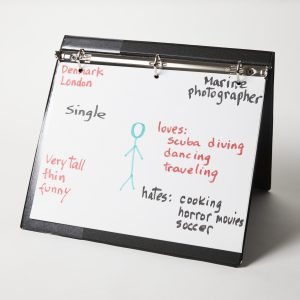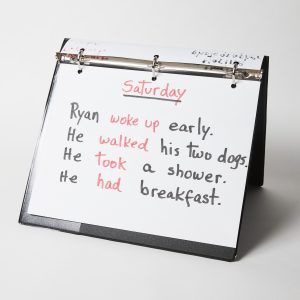23 My Diary
| Level | Materials |
| A1-A2
|
Sheets of A4 paper
Optional: a binder |
Note: This is an activity that I developed for real-beginners, and I usually start using it after the first 10 hours of class. The purpose is to provide student-centered content while practicing full sentences. When I first created this tool, I had students come up with a character who became the “group’s friend” with just a few important pieces of information. I used a binder which I affixed to the wall (see picture below) and lots of color, as you can see. Recently, I have incorporated the use of dice (see Introduction to Role-Playing Adventures for instructions on how to use dice) to provide some more variety to the situations and avoid stereotypes.
The ‘Diary Project’ starts with the students creating an imaginary friend and writing this friend’s diary everyday as a whole class. The first entries usually have four or five short sentences. As students progress, these sentences become longer and more complex. For example, students start using connectors, such as, and, but, so. Every day the class as a whole reviews the entries of the week before and students are encouraged to memorize these short sentences (the teacher may resort to group memory, i.e. , all students try to remember together – some students will remember one part, others will remember another part). See the pictures below to have an idea of how the sentences progress from simple structures to more complex structures. All the sentences are contributions of the students themselves, and the teacher acts as a facilitator by translating the sentences from the students’ native language (monolingual classes only) to the target language or by recasting them.
The “diary project” also provides a context to what is being covered in class. For example, the first few classes using the diary are dedicated to creating the character – name, origin, age, occupation, appearance, likes and dislikes, etc. – which are topics usually covered in the beginning of the course. We then go on to routines (What did so-and-so do on Saturday? So-and-so went to the beach. So-and-so went swimming. So-and-so had lunch. So-and-so ate fried fish.)
I would like to note that every class will produce a different diary. Also, because I use the same classroom for different groups, my students usually become interested in what other groups create and sometimes even ask to participate in their stories, and I encourage them to ‘interact’ with the other characters. Once, a group read that the character from another class was traveling to France. Their own character was from France, so they offered to take the other group’s character out and even offered a couch he could crash on.
How to develop the project
Step 1 – Creating a character.
Start drawing a stick figure on the board and ask the class what the gender of the figure is. Elicit the information about the the character and write the information (just the key words) on the board. If students don’t understand, provide help. Below is an example of what usually happens with me (S stands for any student and T for teacher):
T: What’s the gender of our friend? (draw a boy and a girl on the board)
S: a boy
T: Okay, a boy (erase the drawing of the girl). How old is he? (blank look on students faces). I am 65 years old. John, how old are you? 19? 20?
John: quinze (fifteen in Portuguese).
T: Okay. John is 15. I am 65. How old are you, Maria? (go around asking students how old they are). So, How old is our friend?
S: 23
T: (write the number 23 somewhere around the drawing of the boy). Now, where is he from? I am from Vitoria da Conquista, Brazil. And you, Carlos? Where are you from?
And so on until you have all the information you want.
I usually ask for the following pieces of information:
- Boy or girl? Is our friend a boy or a girl?
- Age – How old is s/he?
- Origin – Where is s/he from?
- Where s/he lives – Where does s/he live?
- Occupation – What does s/he do?
- Civil status – Is s/he single or married?
- Appearance (in general) – What does s/he look like? Tall or short? Slim? etc
- Likes – What does s/he like doing in his/her free time?
- Name (my final question) – What’s his/her name?
At the end, you may have something like this on your board:

Copy what you got on the board to a A4 paper and affix it to the binder.
For the next 2 or 3 classes, review the character (what do you remember about our group friend?). You can also start including other information. For example: Does he have a girlfriend? If he is married: Does he have children? About the basketball: how often does he play basketball? And so on.
Step 2 – Writing the diary
Note: I have monolingual groups, so if they don’t know how to say something in English, I simply accept their suggestion in Portuguese and write the sentence in English on the board. If they say it in English, and there is any mistake in their sentence, I don’t draw attention to the mistake. I just write the sentence correctly on the board. If you have a multilingual class, you may consider using mimic or allowing them to look something up in their dictionaries.
Tell the class that they are going to write Eddie’s diary. Ask someone to say a day of the week. For example, Saturday. Write Saturday on the top of the board. Ask students, “What did our friend do on Saturday?” (again, if they don’t understand, provide several examples of what you did, elicit students to say what they did, until you are sure they understand). As students suggest, roll the dice to see if it is true or false. If false, elicit alternatives.
For example:
T: So, what did our friend do on Saturday?
S: Ele foi ao clube jogar basketball.
T: He went to the club to play basketball. Let’s see (roll the dice). A 2! I’m sorry, he didn’t go to the club to play basketball. What did he do?
S: He go visit mother.
T: He visited his mother. Let’s see (roll the dice). A 5! Yes, he visited his mother (write the sentence on the board).
Based on the first sentence (he visited his mother), elicit 3 or 4 more sentences. In this case, for example, you could ask: What time did he go? How did he go? What did he do there? Did he have a good time? How was his mother? And so on. In the beginning, start with 4 or 5 short sentences. Write them on the board. Have students read the sentences. While they read, take note of the sentences they produced and add them to the binder* on the wall (or to a digital application, such as Padlet). See the picture below. Notice that I use a lot of colors.
*Note: I use a four-ring binder as the character’s “diary”, and I keep it on the wall. Every class, I add one sheet.


During the next few classes, review the diary by challenging students to try to remember what happened. Then add another page with another short situation. Go on adding to the diary as often as you think is adequate for your class. Little by little, as your students become more proficient, you can have them produce longer sentences or have the situation organized in the form of a paragraph.
Here are some other things I used with the diary:
- I selected the verbs that appeared and used the “verbs in movement” activity (see Verbs in Movement chapter).
- I used a group friend to explore something we were working on in our textbook. For example, if the book lesson was about family, we created a family for our group friend. If we were talking about routines, we described our friend’s routine.
- If my classroom was being used by other classes at the same level, there would be other binders affixed to the wall with the diaries of the characters created by the other groups. I encouraged them to read what was going on with another group’s friend. Once, when we were talking about invitations, I asked them to write an invitation to another group’s friend and we sent it. They were super excited when they received an answer accepting the invitation.


Feedback/Errata